Patient Education

Facts on Cancer of the Larynx
Cancer of the larynx strikes approximately 12,000 persons in the United States each year and causes 3,800 deaths. It is mainly a disease of white males, although it is becoming more common among blacks. The ratio of males to females with cancer of the larynx is 4 to 1. The average age of these patients is 63. Almost all those who develop cancer of the larynx use or have used tobacco and many are also heavy drinkers of alcohol. If detected early and treated promptly, the five-year survival rate for cancer of the larynx is over 80 percent. Yet studies have shown that nearly one-third of patients cured of cancer of the larynx or other areas of the upper respiratory and digestive tracts will develop another cancer in those regions especially if the person continues to smoke and drink.
What is the Larynx?
Often called the voice box, the larynx is a complex structure of bone, cartilage, and soft tissue located at the top of the trachea or windpipe. It contains three distinct regions.
- The glottis, consisting of two bands of tissue known as the true vocal cords.
- The supraglottis, a larger area above the true vocal cords that contains several folds of tissue, including the bulkier false vocal cords; and
- The subglottis, a small compartment connecting the vocal cords and the windpipe.
When air is exhaled against the true vocal cords, they vibrate and create sounds. The greater the air pressure, the louder the sound. Pitch is controlled by the speed of vibration. Since the vocal cords in men are usually thicker and longer than in women, they vibrate more slowly, creating a lower pitch or deeper-sounding voice.
What is Cancer?
Cancer is really a number of diseases caused by the abnormal growth of cells. Normally, the cells that make up the body divide and reproduce in an orderly manner, so that we can grow, replace worn-out tissue, and repair any injuries. Sometimes, however, cells get out of control. They divide too much and form masses known as tumors. Some tumors may interfere with body functions and require surgical removal, but do not spread to other parts of the body. These are known as benign tumors. Malignant or cancerous tumors not only invade or destroy normal tissue, but, by a process known as metastasis, cells break away from the original tumor to other parts of the body. There they form more malignant tumors. Cancers can spread rapidly or take years to grow. Cancers of the true vocal cords progress slowly, but cancers of the false vocal cords grow rapidly and quickly spread to the lymph nodes.
Signs and Symptoms
The most frequent and important sign of cancer of the larynx is persistent and worsening hoarseness. Although hoarseness may be caused by any condition that inhibits the vibration and movement of the vocal cords, it could also result from a tumor on the vocal cords, the most common early site of cancer of the larynx. Cancers of the vocal cords are not painful until later stage disease, when nearby tissues are involved, producing a chronic cough as well as hoarseness. Early growths elsewhere in the larynx can cause a change in voice pitch, a sense of discomfort in the throat, a lump in the throat, coughing, difficulty or pain in breathing or swallowing, and earache. In these instances, hoarseness may not develop until much later, if at all. Any of these conditions that last more than two weeks should be checked by a doctor.
Detection and Diagnosis
Most tumors of the larynx can be detected by a doctor using a laryngeal mirror. This resembles a dentist's mirror with a long handle. For closer inspection a laryngoscope, a lighted tubular instrument, may be used. The throat is first numbed with a spray or local anesthesia and the device is inserted through the mouth into the larynx. If a tumor or suspicious looking growth is located, a small tissue sample will be removed and later examined under a microscope to see if cancer cells are present. Further diagnostic procedures can help determine the stage or severity of disease and the appropriate plan of treatment. These procedures could include: laryngogram, an X-ray of the larynx, tomogram, an X-ray of a cross-section of tissue; and Computerized Axial Tomography or CT Scan, a 3-dimensional X-ray.
Treatment for Cancer of the Larynx
Treatment for cancer of the larynx varies according to location, size, and stage of the tumor, and individual characteristics, such as age and physical condition. In general, cancer of the larynx is treated with radiation or surgery or a combination of the two. There have been some promising results using drugs, or chemotherapy, for advanced cancers of the larynx.
Radiation
Early cancers of both the true and false vocal cords can be successfully treated with radiation alone. The basic principle of radiation therapy is to treat a cancer with X rays to damage or destroy cancer cells, yet produce only minimum damage to surrounding tissue. New computerized techniques allow this to be done even more precisely. The side effects of radiation can include skin reactions, nausea, vomiting, and a feeling of tiredness.
Surgery
Certain selected early tumors can also be treated by limited surgery that removes only part of the larynx. In recent years, laser treatment--the destruction of the tumor by intense light beams--has become more common. Both limited surgery and laser treatments preserve the voice, although speech may not be as good as before the procedure. For advanced cancers or when the cancer persists following radiation, total surgical removal of the larynx may be necessary. This procedure is known as a laryngectomy. It may be combined with surgery and, at times, radiation to the lymph nodes of the neck. Because it eliminates the connection between the lungs and the mouth and nose, an opening, called a stoma, must be created in the lower part of the neck. The patient is able to eat and drink normally, but must breathe, cough, and sneeze through the neck opening. Most laryngectomees (those who have had a laryngectomy) can also learn to speak again through a technique known as esophageal speech. For those who cannot master esophageal speech, the recent use of special surgically implanted shunts provides an alternative. Electronic, battery-operated devices can be held against the throat to produce speech. Although speech sounds electronic, these devices offer a welcome relief from having to communicate only in writing. They can help in emergencies when emotions may interfere with esophageal speech.
Prognosis
Cancer of the larynx has an encouragingly high cure rate. As is true in most forms of cancer, the outcome depends largely on how early the tumor was discovered and treatment begun. For tumors treated when they are still small and confined to the local area, the five-year survival rate exceeds 80 percent. For advanced cancers, the five-year survival rate varies from 26 percent to 52 percent, depending on the number of lymph nodes the cancer has involved and whether it has spread to distant organs.
Rehabilitation
A major goal of the health care team and of patients themselves is to return to a lifestyle as close to normal as possible. Laryngectomees, however, must restrict some activities. Because air inhaled through the stoma goes directly to the lungs, laryngectomees are advised to avoid jobs or activities that involve extreme heat or cold or gases, fumes or dusts. Swimming is also ruled out, since the water could flow right through the stoma and into the lungs. Much of the senses of taste and smell are lost, although these return to some extent with time. At least two-third of all laryngectomees are successful in learning esophageal speech. Patients are often taught this technique who have themselves had a laryngectomy and mastered esophageal speech. The individual learns how to swallow air and force it into the esophagus, the tube that carries food from the throat to the stomach. When air is expelled, it causes the walls of the esophagus and pharynx, the passageway above the larynx, to vibrate. This in turn vibrates the column of air in the passages, causing a low-pitched sound. Tongue, lips, teeth, and palate transform this sound into words. Learning speech that can be understood by others can take a few weeks or a few months or a year. It can even be learned by patients who have had laryngectomees several years ago and have not spoken since. Some individuals are able to perfect esophageal speech and resume careers in which speech is of primary importance, such as telephone orators, speech teachers, and sales representatives. For those unwilling or unable to learn this new way of speaking, a number of products can be used to create speech. These include an electronic larynx and mechanical device that fits into the stoma and uses exhaled air to create a voice. Also available are electronic amplifiers for persons whose esophageal speech is not loud enough. A nationwide network of volunteers helps recovering patients cope with and overcome the emotional and physical problems associated with treatment for cancer of the larynx. These volunteers have themselves had laryngectomees and are members of Lost Chord, Anamilo, or New Voice Clubs. More than 325 of the clubs are members of the International Association of Laryngectomees, an affiliate of the American Cancer Society. These volunteers teach recovering patients how to speak, how to shower, and to otherwise resume their previous lifestyles as much as possible and as quickly as possible. They are living proof that successful rehabilitation is possible after a laryngectomy. At a doctor's request, an IAL volunteer will visit a patient in the hospital, bringing a kit of basic assistance items and informative literature and offering peer counseling and advice. Because cancer recurs in approximately one-third of patients treated for cancer of the larynx, regular follow-up examinations are important. Recurrence of cancer of the larynx or a new cancer in another part of the respiratory tract can be successfully treated if detected early. The greatest risk is in the first 18 months after the initial treatment.
Hope for the Future
Hope for the future lies in two major areas--earlier detection and prevention. Cancer researchers are improving methods for diagnosing cancer of the larynx, learning more about the behavior of early cancers, and developing more effective combinations of treatments. Individuals can help themselves by avoiding all forms of tobacco use and drinking only in moderation. The movement toward generally healthier lifestyles could prevent most cases of cancer of the larynx.
Used with permission to reprint granted by the American Cancer Society
What is a laryngectomy?
For patients requiring a laryngectomy, the prospect of losing the voice may be the most disturbing element of the operation. The patient often fears the psychological, social and economic impact upon himself or herself and family. Rapid, effective rehabilitation, particularly of speech, can greatly lessen this impact by restoring the patient to his or her full capacity. A laryngectomy is the surgical removal of the larynx. The larynx, also called the voice box, is the organ in the throat that creates speech and, in conjunction with the epiglottis, prevents food from entering the airway during swallowing. It lies between the trachea (windpipe) and the upper part of the airway known as the pharynx, forming part of the tube in the throat that carries air to and from the lungs to create speech, air from the lungs is expelled over the vocal cords in the larynx, resulting in vibrations, which are modified by the tongue, palate and lips. When the larynx is removed, the top of the trachea immediately below the larynx is attached to a permanent opening made in the throat called a stoma. It is through this opening that the laryngectomee breathes.
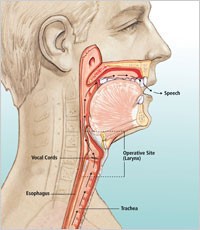

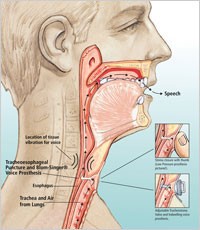
Understanding Voice Restoration
With persistence, a laryngectomee can learn from a speech pathologist new ways of speaking. One option, called Esophageal Speech, involves the patient learning to breathe in a manner that injects air into the pharynx, expelling it in a controlled way to form voicing. Another option, known as an Artificial Larynx, uses a speaking aid device that emits a vibrating noise and is held against the throat. By mouthing words, a laryngectomee converts the vibrations into speech. A third option, called Tracheoesophageal Puncture (TEP), is described below.
Blom-Singer® Voice Prostheses and Tracheoesophageal Puncture (TEP)
Today, advances in medical technology enable speech production by means of voice prosthesis. By creating a small surgical passage (TEP) just inside the stoma, from the back wall of the trachea into the esophageal wall, a small one-inch valved tube (voice prosthesis) can be placed into this passage to enable tracheoesophageal speech. Voice is produced by temporarily blocking the stoma, either with a finger or an adjustable tracheostoma valve, so that exhaled air from the lungs can be directed from the trachea through the prosthesis into the esophagus (where vibrations are produced) and then out through the mouth. Fluent, conversational speech may be acquired within a few days. Blom-Singer voice prostheses have set the standard in post-laryngectomy voice restoration since 1979. Drs. Blom and Singer continue to introduce innovative procedures and medical devices allowing thousands of patients worldwide to regain their ability to speak.
Methods of Voice Restoration
The inability to speak is usually the most distressing problem confronting the laryngectomy patient. Today, many choices are available to help restore speech. Rapid, effective rehabilitation, particularly speech, is critical to avoid the psychological, social, and economic consequences frequently experienced by the laryngectomee and his/her family. The larynx (voice box), is the organ in the throat responsible for voice production and for preventing food from entering the airway during swallowing. It lies between the pharynx (upper part of the airway) and the trachea (windpipe), forming part of the tube in the throat that carries air to and from the lungs. One function is to prevent choking. When a person is not eating or drinking, the epiglottis stays upright, keeping the larynx open as part of the airway to the lungs. As soon as swallowing begins the epiglottis drops like a lid of the larynx, directing food over to the esophagus (food pipe). A second function of the larynx is voice production. Air from the lungs passes over the vocal cords resulting in vibrations which are modified by the tongue, palate, and lips to produce speech.
- A. Tongue press to inject air into esophagus
- B. Air enters esophagus
- C. Air released from esophagus to produce voice
- D. Voice shaped into speech
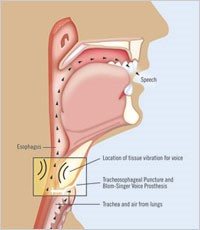

When the larynx is removed (laryngectomy), the top of the trachea immediately below the larynx is attached to a permanent opening (stoma) made in the throat. The patient will then breathe through the stoma. With persistence, the laryngectomee can learn from a speech therapist new ways of speaking, either by esophageal speech where air is injected, then expelled in a controlled way to form voice, or by using a speaking aid device known as an electrolarynx. This device emits a vibrating noise and is hand-held against the throat. By mouthing words, the laryngectomee converts the vibrations to speech. Today, advances in medical technology enable speech production by means of a voice prosthesis. By creating a small surgical passage (TEP, or Tracheoesophageal Puncture), inside the stoma, from the back wall of the trachea into the esophageal wall, a small one- inched valved tube (voice prosthesis) can be placed into this passage to enable tracheoesophageal speech.
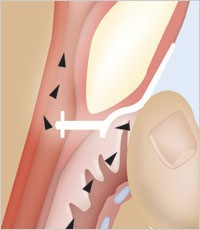
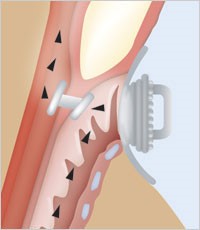
Voice is produced by blocking the stoma, either with a finger or an adjustable tracheostoma valve, so that exhaled air from the lungs can be directed from the trachea through the prosthesis into the esophagus (where vibrations are produced) and then out through the mouth. Fluent, conversational speech is usually acquired within a few days. Blom-Singer voice prostheses have set the standard in postlaryngectomy voice restoration since 1979. Drs. Blom and Singer continue to introduce innovative procedures and medical devices allowing thousands of patients worldwide to regain their ability to speak.
How can I get more connected?
Websites
- International Assocaition of Laryngectomees - Support group
- WebWhispers Nu-Voice Club - Internet support group
- American Cancer Society (ACS) - Information



